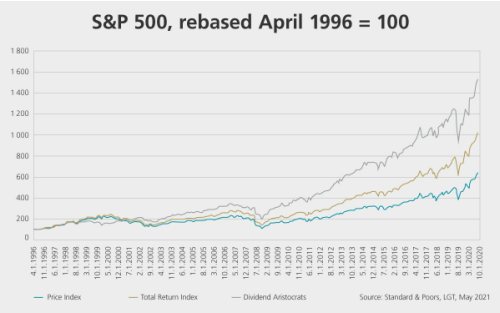In times of change, challenging prevailing assumptions can be critical. What investment strategy can be used to counter today's uncertainty in the financial markets?
By Wilson Cheung, Investment Strategist and Stefan Hofer, Chief Investment Strategist (LGT Private Banking Asia).
Perhaps one of the most often repeated maxims in financial markets is that equities reward patient investors: those who can hold on for the longer term. For example, had an investor placed $100 into a basket of globally diversified stocks in 1995, the returns excluding dividends as per June 23 2021 would be +379 percent – taking the MSCI All Countries USD price index as a benchmark.
Put differently, over this very long period, the average monthly return for global stocks was +0.6 percent. The best month produced gains of +22.5 percent whereas the worst monthly loss was -32.9 percent. The range between these highs and lows is clearly significant, which is arguable, why some observers remarked that it is «hard to time the market».
How Important Is Timing When Investing?
An overemphasis on trying to pinpoint the best moment to enter or exit the market could result in material losses, but holding over the longer-term smooths out these hills and troughs.
That said, many investors might not be content with using «time» as their driving investment strategy. To beat the longer-term average return, so-called «active bets» need to be made.
How to Focus Your Investments
As such, the natural course is to make regional and/or sector bets, not just holding the widest, most generic basket of stocks in your portfolio. In our view, the four traditional, most commonly invested regions are the U.S., Eurozone, Emerging Markets and Japan.
If we consider returns in common currency terms (taking the dollar as an example), then over the above-mentioned period of 1995 to June 2021, U.S. stocks delivered the highest average monthly return of +0.8 percent. Europe and Japan come in second at +0.6 percent and Emerging Markets (in dollar terms) come in third at 0.2 percent. What is perhaps more interesting is to consider the range of monthly returns across these four regions.
The monthly range is calculated by taking the best performing market less the worst performing market. Over the long run, the average monthly range of returns is 7.0 percent. This implies that on any given month, a strong bet on the winning market would result in a performance that is well above the average – which in turn is what so-called active investment managers seek to do (and charge fees for).
Turning to global sectors, the potential for outperformance is even greater. Taking the standard global eleven sectors' performance, the average monthly range of performance is +9.4 percent. This suggests that the scope of beating the market average is higher in active sector selection as opposed to region or market selection alone. By definition, however, the downside risks are also higher.
Traditional Investment Approaches: Value vs. Growth
Perhaps another common maxim in financial markets is that individuals should «invest in what they know». By doing your homework on the economic cycle, fiscal and monetary policy, companies, sectors and markets, investors may develop an affinity or sense of confidence in making active bets in the market.
They may also form an overarching philosophy to investing; famous examples Value versus Growth investing. The former focuses on seeking out investments that are arguably cheaply valued against their balance sheet of profitability fundamentals. The latter advocates for focuses on future earnings growth potential, placing less emphasis on current valuation metrics.
Integrating Dividends in Your Strategy
What we currently see in the market is a renaissance in the dividend-style of investing. Indeed, as the below chart shows, over the longer term, dividends play an important part in investors' total returns. In part, this is because companies overall are reinstating or increasing their dividend payouts following a global rebound in profitability.
(Click to enlarge)
The U.S. investment bank J.P. Morgan estimates that in 2020 alone in Europe, 236 companies in the EuroStoxx600 index cut their dividends. Now that the economic recovery in Advanced Economies is accelerating, it stands to reason that investors are paying attention to dividend growth stocks, as many of those companies will again be in a position to reward shareholders with these payments.
Rising Dividend Payments
Indeed, there is an interesting variation on dividend investing: this is known as Dividend Aristocrats. These are companies that consistently increased their dividend payouts over the past 25 years, and as the same chart demonstrates; their long-term performance is compelling.
At LGT we are strong advocates of investing in firms that have the capacity and intention to grow these payouts and anticipate that the current economic recovery keeps this style in vogue. Rising dividend payments may also act as a buffer against market volatility over the coming months, as investors ongoingly re-assess the U.S. inflation and monetary policy outlook.












